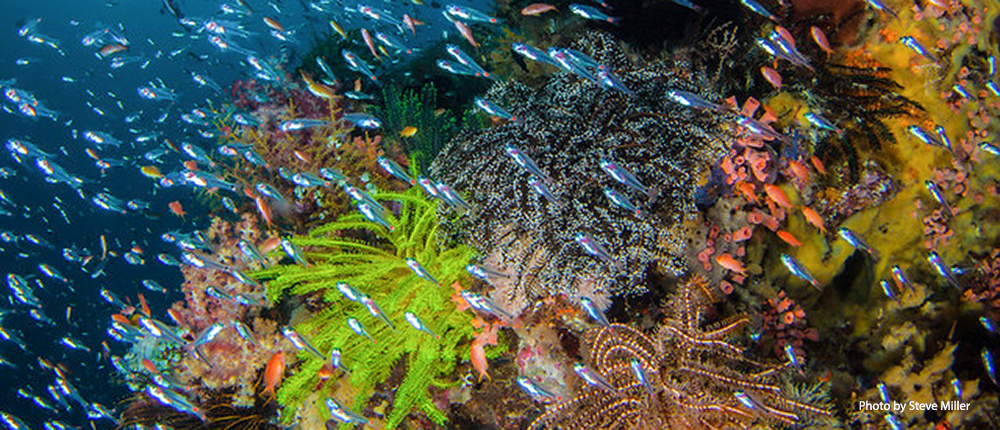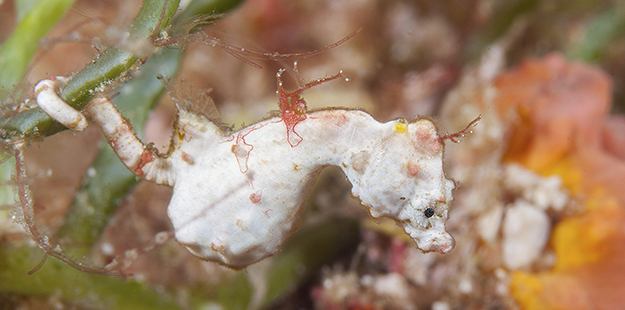The Place for Photo Ops
Wakatobi is an ideal destination for underwater photographers
There are reasons why Wakatobi Resort is at the top of many underwater photographer’s bucket list of destinations. In fact, you might say that there are thousands of reasons, because that’s the number of unique forms of marine life that can be found in these waters. And it’s not just about numbers, but also about the ease of access and frequency of opportunities that are provided. For underwater photographers seeking a diversity of marine life subjects, this is definitely the place to be.
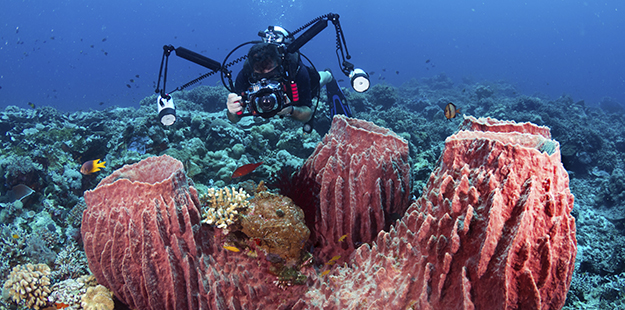
Thanks to conservation initiatives put into place 20 years ago by Wakatobi’s founders, the reefs within a 20km area around the resort remain healthy and pristine, and especially attractive to underwater photographers. Photo by Walt Stearns
An unspoiled and protected seascape
The Wakatobi region lies in the heart of the Coral Triangle, a region of the Indo-Pacific that supports the highest biodiversity of marine organisms in the world. But while this area is indeed home to a diverse and rich collection of species, it also has man-made stresses, with reefs in some areas subject to the pressures of destructive fishing practices and development. It was the desire to eliminate these threats that have inspired the team at Wakatobi Resort to devote more than two decades of stewardship through the Wakatobi Collaborative Reef Conservation program. “As the world’s ecosystems change before our eyes, thankfully Wakatobi Resort is remote enough, and protected with enough forethought, that its bounty remains.” says Dr. Richard Smith.
“The bustling reefs with their fantastical tropical fishes, kaleidoscopic corals and many special resident characters keep bringing myself and other divers back to Wakatobi Resort year after year.” ~ Dr. Richard Smith
Luckily, there are also places where nature still exists in an unspoiled and pristine form, and a 2.5 flight on our exclusive charter from Bali to Wakatobi Resort will transport you to a remote corner of the world that our founders and team have worked tirelessly to protect.
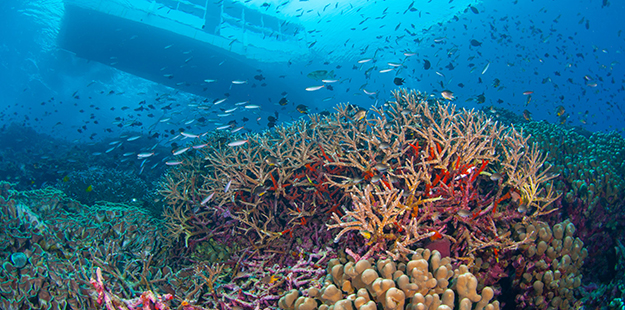
Dive sites like Zoo, which is just a 5-minute ride from the resort, provide an ideal environment for photographers of all skill levels. Photo by Mathis Weatherall
Ideal photo environment
Ongoing and diligent conservation and protection efforts within Wakatobi’s marine preserve creates an underwater environment that is ideal for underwater photography. Dive sites are covered in a kaleidoscope of soft corals and sponges that swarm with life, and tumble downward from bright shallows to disappear into the abyssal blue below. Ridges and seamounts bring life-giving sunlight to hard corals, and unsullied bays provide the protection needed for the reef’s more delicate creatures to flourish.
The shallow reef crest in front of Wakatobi Resort is easily accessible from shore. From depths of less than two meters slopes and walls plunge dramatically to 100 meters and beyond. Here turtles, trevally, frogfish, ghost pipefish and four species of pygmy seahorses find their home on a reef that tears the underwater photographer’s attentions from macro to wide-angle in the blink of an eye.
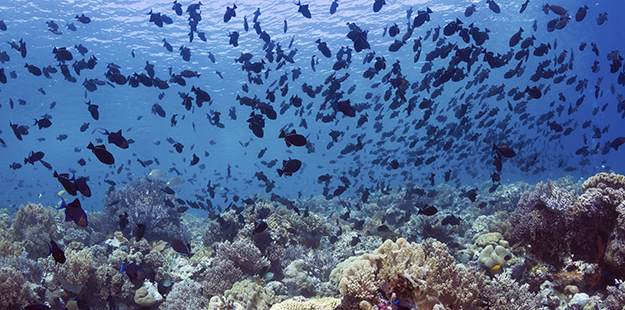
Fisheye lenses such as the Tokina 10-17 fisheye zoom used to capture this image are excellent tools for photographing Wakatobi’s shallows and grand seascapes. Photo by Walt Stearns
Given the wide variety of subjects that are available on the resort’s House Reef, DSLR shooters are advised to bring a full compliment of lenses. A favorite of many macro photographers is a 100/105 mm, which creates a bit of space between the photographer and the smaller, shier creatures. Thanks to Wakatobi’s generally excellent water clarity, there is rarely an issue with sediment in the water. Fisheye lenses are also excellent in the shallows, where shooters can make the most of the high coral coverage to create Snell’s window effects in the calm waters.
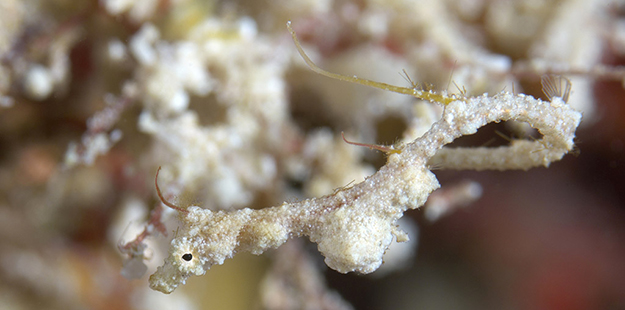
Among the highlights of macro subjects you will find at Wakatobi are four species of pygmy seahorse, plus the recently described pygmy pipehorse ( Kyonemichthys rumengani), seen here. Image taken using a 105 mm macro lens. F22, 1/125th, ISO 100. Photo by Richard Smith, facebook.com/OceanRealmImages
Small opportunities
Wakatobi is well known in underwater photography circles for its wealth of macro subjects. Indeed, one could spend an entire week within 100 yards of the resort pier and not exhaust the area’s macro potential. Among the signature range of subjects found in this area are a huge variety of nudibranchs, abundant anemonefish; numerous shrimp species including imperial, bubble coral and crinoid; robust, ornate and halimeda ghost pipe fish; four species of pygmy seahorses – Bargibant’s, Denise’s, Pontoh’s and Severn’s, and the recently described pygmy pipehorse, (Kyonemichthys rumengani).
And one doesn’t need to be a professional-level shooter to create some great images. Much of the marine life at Wakatobi can be shot using a compact camera with a single strobe. Because some of the smallest creatures might be just that little bit too small, the use of an external macro lens will enhance the ability to capture these subjects.

Inquisitive Big-eye trevally are often found roaming the shallows off the House Reef. Photo by Richard Smith, facebook.com/OceanRealmImages
Don’t forget to go big
Photographers can easily get lost in capturing the small details, but it would be a shame to miss the big picture. This is where a wide-angle or fisheye lens will enhance creativity for stunning reef scenics. The reefs of the Wakatobi preserve are absolutely stunning and have a lot to offer the wide-angle photographer. Walls that begin in shallow depths are covered in a diverse array of soft corals, sponges and gorgonians. The clear waters provide ample ambient light to showcase these vistas in vibrant detail.
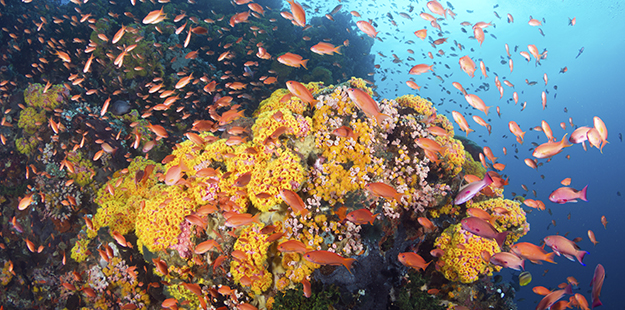
Often a great time for wide angle photography is during tide changes when the current is running, which enhances the activity on the reef. Photo by Walt Stearns
Similar scenes can be captured on seamounts covered in hard corals, and it is common to find green and hawksbill turtles as amenable subjects, or to come upon swirling schools of big-eye trevally, bumphead parrotfish and barracuda.
Things to keep in mind
Take a few moments to look at the reef from a different perspective. The huge variety of invertebrates such as soft corals, anemones and sponges provide a rich palette of unique abstract subjects. On virtually every dive, both macro and wide-angle will be great but it is worth checking with your guide whether there are any specialties you should know about.

Wakatobi’s dive guides are a wealth of knowledge on subject matter, and provide excellent support for photographers whenever required. Photo by Walt Stearns
Be sure to take advantage of services and assistance provided by Wakatobi’s experienced dive guides. These professionals can not only assist with equipment handling and logistics both in and out of the water, but are also a wealth of knowledge on marine life and environment, and have an almost uncanny ability to locate hidden and rare subjects. For the ultimate in photo support, some guests will opt for a private guide.
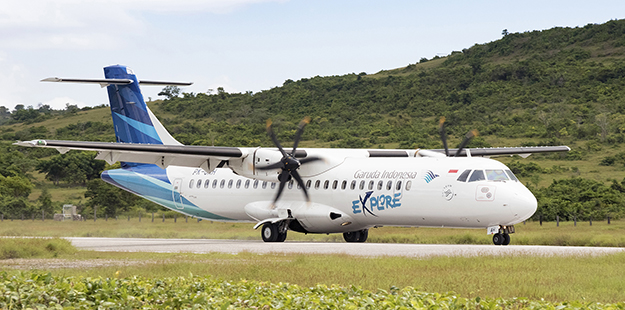
Our private flight on a Garuda Group’s newest 70-seat ATR-72 600 plane provides ample space for all guests, their gear and photo equipment. Photo by Wakatobi Resort
Baggage capacity is not an issue from Bali as the resort’s exclusive charter flight with the Garuda Group is designed so that guests can bring all their equipment and gear with them. If baggage becomes a challenge on your international flight, it might make sense to leave some dive gear behind in favor of camera accessories. The resort has a well-stocked dive center where quality gear can be rented – just let us know in advance.
As a final note, be sure to take advantage of all the opportunities provided by the House Reef. In addition to the three boat dives offered per day, guests have unlimited access to the House Reef, which is monitored by dive staff from 6am until 10pm. From that point on a resort security team are on watch. Dives can begin directly from shore, or by getting dropped off down the reef by taxi boat; service is available from 6:00 am until 5:30 pm. The beauty of diving the House Reef is that divers can go as slowly as they like, making the most of the abundant macro and wide-angle photography opportunities.
Acclaimed marine biologist and photographer Dr. Richard Smith has extensive knowledge of the exceptional marine life found on area reefs and walls, and on more distant sites reached from the Pelagian liveaboard. Having spent years completing his PhD research at Wakatobi, Richard is considered an expert in the diving and marine life found in this region.
Don’t miss your opportunity to experience Wakatobi Resort and Pelagian Dive Yacht to explore the exciting underwater world that awaits you in Southeast Sulawesi, Indonesia.
For more information contact us at office@wakatobi.com.


